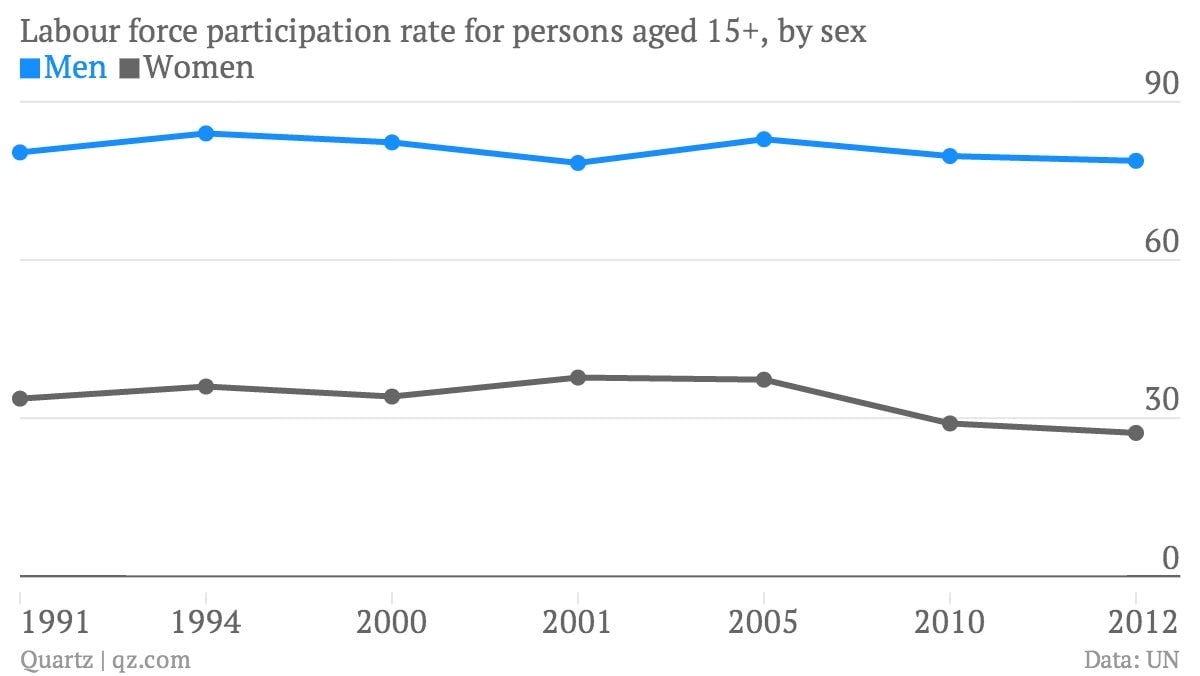India’s record in women’s participation in the workforce is depressing
India ranks the second lowest in the Group of 20 (G20) economies when it comes to women’s participation in the workforce, according to a report published by aid group Oxfam this month. It is above only Saudi Arabia, a country that does not allow its women to drive.


India ranks the second lowest in the Group of 20 (G20) economies when it comes to women’s participation in the workforce, according to a report published by aid group Oxfam this month. It is above only Saudi Arabia, a country that does not allow its women to drive.
That is bad enough, but it doesn’t end there.
When it comes to women’s economic participation, India’s position seems fixed at the bottom even when we compare it to the entire world and not just the 20 major economies. It ranks 124 out of 136 nations, according to a World Economic Forum (WEF) report from last year.
All the BRICS nations rank much higher than India. The 12 countries below India include countries riven by political instability, such as Pakistan, Egypt and Syria.
India is one of the few countries where the rate of participation of women in the workforce has drastically declined in the last decade. It fell from 33.7% in 1991 to 27% in 2012, according to UN gender statistics.

In 2011-12, less than 20% of the total workers in non-agricultural sectors were women, according to India’s statistics department. Manipur, Tripura, Tamil Nadu and Kerala have the highest percentage share of women in wage employment in non-agricultural sector. Bihar, Jharkhand, Uttarakhand and Uttar Pradesh report the lowest.
“Labour markets in industry and services sectors in India are heavily male dominated and a 50:50 situation for men and women is too ideal to be true given the market dynamics and existing socio-cultural framework,” noted a government report we wrote about last week.
There is one underlying positive trend that might also be contributing to the lower numbers of women at the workplace.
According to the International Labour Organisation (ILO), increasing number of working age women are enrolling in secondary school and that accounts for some of the decline in female worker participation since 2004.
But even educated women are opting out of full-time employment. Research by Everstone Capital showed that while the number of women enrolling in college has grown manifold, it has not translated into a proportionate increase of women graduates in the workforce.
At 22%, the rate of India’s female graduates entering the workforce is lower than the rate of illiterate women finding a job.
The low numbers of educated women in the workforce are evident in boardrooms. Women in India, according to research firm Catalyst, hold barely 5% of board seats—lower than all other BRICS countries. A progressive new law has been passed this year that requires all companies listed on the stock exchanges to have at least one woman board member.
Occupational segregation also holds women back. There are only certain industries and services such as basic agriculture, education, handicraft manufacturing and sales that welcome women workers in India, the ILO report said. Female employment grew by 9 million between 1994 and 2010, but the ILO estimates it could have increased by double that figure if women had a level playing field.
Women are more vulnerable to exploitation and harassment at work in developing countries. In India, they earn 62% of the men’s salary for equal work, according to WEF. They are also unable to effectively fight against harassment.
India passed a new law against sexual harassment last year, under which organisations with more than 10 workers have to set up grievance committees to investigate all complaints. But according to a study by Jawaharal Nehru University (JNU), less than 20% employers in New Delhi comply with the rules.
All of this is costing India dearly. The country’s GDP can increase by more than a quarter if it can match male and female employment rates, according to a report by consulting firm Booz & Co.